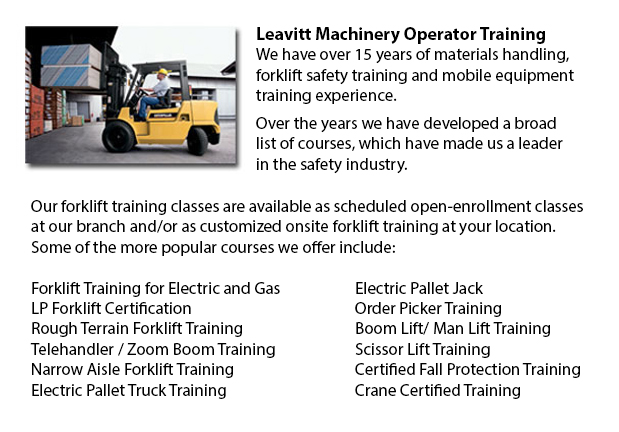
Forklift Training Programs Red Deer - Are you searching for a job as a driver of a forklift? Our regulatory-compliant mobile equipment operator training offers instruction in kinds of lift trucks, pre-shift check, fuel types and dealing with fuels, and safe utilization of a lift truck. Practical, hands-on training assists those participating in acquiring fundamental operational skills. Course content includes existing regulations governing the operation of lift trucks. Our proven forklift courses are meant to offer training on these types of trucks: counterbalanced forklift, powered pallet trucks and narrow isle forklift.
How to Safely Handle Loads
Do not raise or lower the fork while the forklift is moving. A load must not extend above the backrest due to the risk of the load sliding back in the direction of the operator. Inspect for overhead obstacles and make certain there is enough clearance before raising a load. Stay away from overhead power lines. Once the load is lifted straight up, tilt it back slightly.
The lift truck is less stable if a load is in a raised position. Make sure that no body ever walks below the elevated fork. The operator should never leave the lift truck while the load is lifted.
The forks should be level when handling pallets, and high enough to extend all the way into and below the load. The width of the forks must provide even distribution of weight.
Set the brakes and chock the wheels before unloading and loading the truck. The floors should be strong enough to support the weight of both the load and the forklift. Fixed jacks could be installed in order to support a semi-trailer which is not coupled to a tractor. The entrance door height should clear the forklift height by a minimum of 5 cm. Edges of ramps, docks and rail cars must be marked and avoid them.
If there is not proper ventilation into the forklift, do not stay in there for extended periods. The trucks interior should have adequate lighting and be free of obstructions. Check the flooring of the forklift cab for holes. The installation of material that are non-slip on the floor will help avoid slipping. Clear whichever obstacles from dockplates and docks and ensure surfaces are not oily or wet.
Never tow or push other vehicles utilizing a lift truck.
-
Fall Protection Ticket Red Deer
Fall Protection Ticket Red Deer - The number one reason of death in the construction industry come from fall-related incidents. There is more possibility for fall accidents depending upon the kinds of work being done in your workplace. Therefore, kno... More -
Overhead Crane Certification Red Deer
Overhead Crane Certification Red Deer - The overhead crane certification course is a course that is designed to help trainees, even if they have language or literacy limitations. The course comprises a practical hands-on training session and a classr... More -
Wheel and Track Loader Training in Red Deer
Lift trucks are obtainable in a variety of various models which have various load capacities. Nearly all typical lift trucks utilized in warehouse settings have load capacities of 1-5 tons. Bigger scale models are utilized for heavier loads, like for... More -
Heavy Equipment Certification Red Deer
Heavy Equipment Certification Red Deer - Heavy duty vehicles are big pieces of machines which are usually known as heavy equipment. It is a broad term that literally includes whatever big utility vehicle in the area of agricultural and forestry imple... More -
Heavy Equipment Operator Classes Red Deer
Heavy Equipment Operator Classes Red Deer - A person who has the correct training to be able to use a particular kind or piece of machine is referred to as an equipment operator. There are different ways that an equipment operator can become trained... More -
Crane Safety Training Red Deer
Crane Safety Training Red Deer - Both crane driver and their supervisors must know all the potential problems related to the operation of an overhead crane. All over North America, there is legislation which provides rules for the safe inspection, ma... More -
Aerial Lift Training Red Deer
Aerial Lift Training Red Deer - An aerial work platform is a mechanized access platform. This device provides access to otherwise inaccessible places for people or equipment. Likewise called an elevating work platform or aerial device, the machinery... More -
Wheel Loader Operator Training Red Deer
Wheel Loader Operator Training Red Deer - In order to lift significant cargo, industrial cranes use pulleys and levers. Before, Romans used cranes in order to put up big monuments making the origin of these machinery at least 2,000 years ago. Numerou... More

Forklift Training Red Deer
TOLL FREE: 1-888-254-6157
Red Deer, Alberta
forklifttrainingreddeer.com
Email Us
About Us


